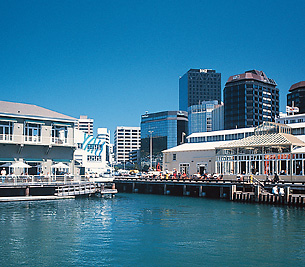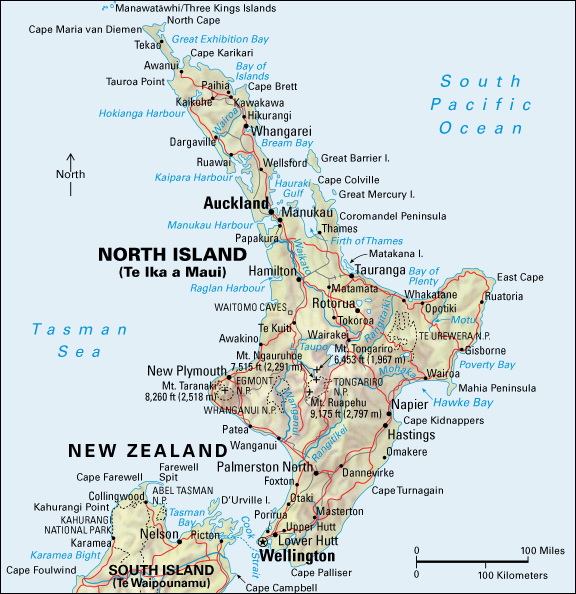Wellington (pop. 202,737) is the capital and one of the largest cities of New Zealand. The city is an important center for government, manufacturing, and shipping. It is also the hub of New Zealand’s air and land transportation routes. Most cultural organizations in New Zealand have headquarters in Wellington. It lies on the southern coast of the North Island. Wellington and the surrounding area make up one of New Zealand’s most highly populated regions.

Wellington lies on the southwestern shore of a natural deepwater harbor, near the southern tip of the North Island. High hills surround most of the harbor and protect it from the rougher seas of Cook Strait. An earthquake in 1855 raised the harbor bed by more than a meter, allowing land to be drained and reclaimed. Much of Wellington’s business district now stands on this land. The city is often windy, and, as a result, is sometimes called “Windy Wellington.”
The city
covers about 110 miles (290 square kilometers) and consists of administrative areas known as suburbs. The Wellington metropolitan area extends beyond Wellington City and includes the urban areas of Lower Hutt, Upper Hutt, and Porirua.

Architecture.
Wellington City has many notable buildings. Government Building, on Lambton Quay, is one of the largest wooden buildings in the world. Built in 1876, this four-story, colonial-style structure was designed to look as though it were made of stone. The Wellington Cathedral of St. Paul, an Anglican church, is one of New Zealand’s most beautiful churches. Examples of colonial houses dating from the 1860’s stand in the suburb of Thorndon.
Wellington’s most famous modern building is known as the Beehive. Completed in 1981, it houses the executive offices of the national Parliament. This cylindrical structure was designed by the British architect Sir Basil Spence. Other notable buildings include the restored Wellington Town Hall, first opened in 1904; the Michael Fowler Centre, a modern auditorium completed in 1983; and the TSB Bank Arena, a sports arena and concert hall built in 1995.
Cultural life.
New Zealand’s national museum, the Museum of New Zealand: Te Papa Tongarewa, overlooks the harbor. It has exhibits on the cultural heritage and natural environment of the country. Wellington is the home base of the Royal New Zealand Ballet and the New Zealand Symphony Orchestra. The Circa Theatre presents a variety of theatrical and dance productions. Taki Rua produces theatrical works rooted in Māori culture.
The National Library of New Zealand includes the Alexander Turnbull Library, which houses the country’s main collection of rare books and manuscripts. The Parliamentary Library contains books related to the government and laws of New Zealand.
Katherine Mansfield, one of New Zealand’s most famous writers, was born in Wellington in 1888. Her house, in the suburb of Thornton, has been restored and features period furniture and other antiques. Although Mansfield spent much of her life in the United Kingdom, many of her stories are based on her early Wellington experiences.
Victoria University of Wellington has three campuses in the city: the Kelburn Campus, the Pipitea Campus, and the Te Aro Campus. In addition, Massey University has a campus in Wellington.

Recreation.
There are many fine beaches near the city, and local parks have facilities for a number of sports. The two main sports grounds in Wellington are Westpac Stadium, one of New Zealand’s chief Rugby Union football grounds, and the Basin Reserve, one of New Zealand’s main cricket grounds.
The Botanic Garden, the Carter Observatory, and the Wellington Zoo are all open to the public. Wellington’s cable car system is a popular tourist attraction. It carries passengers from Lambton Quay, in the central business district, to the Botanic Garden, in the suburb of Kelburn. A platform on top of nearby Mount Victoria offers panoramic views of Wellington’s beautiful harbor.
People.
A large percentage of Wellington’s population is of European ancestry. Other ethnic groups include people of Māori, Pacific Island, and Asian ancestry. English is the most commonly spoken language in the city. Other languages spoken in Wellington include French and Māori.
Government.
A city council is the chief governing body for Wellington. The council consists of an elected mayor and 14 councilors. The Greater Wellington Regional Council is responsible for such matters as emergency management, the environment, and transportation in Greater Wellington, which includes other urban areas.
Economy.
Wellington ranks as one of New Zealand’s chief seaports and manufacturing centers. Its port handles millions of tons of cargo annually. Cruise ships also use the port. Factories in the Wellington area manufacture chemicals, clothing, electrical machinery, processed foods, and other products.
The city is also New Zealand’s financial and administrative center. Many departments of the national government have head offices in Wellington. Many of New Zealand’s banks and insurance companies have their headquarters in the city.
Ferries carry motor vehicles between Wellington and the South Island port of Picton. Electric trains link central Wellington with its more distant northern suburbs. Electric trams are the chief form of public transportation within the city. Two airports serve Wellington—Wellington International Airport, in the suburb of Rongotai, and Kapiti Coast Airport (formerly Paraparaumu Airport), about 35 miles (56 kilometers) north of Wellington. The city has a daily newspaper, The Dominion Post.
History.
Māori lived in the region of present-day Wellington for hundreds of years before Europeans arrived. In 1773, the English explorer Captain James Cook became the first European to sight Wellington’s harbor. Captain James Herd, another Englishman, sailed into the harbor in 1826.
In 1837, the British colonial reformer Edward Gibbon Wakefield formed the New Zealand Association (later renamed the New Zealand Company) to promote British colonization of the islands. Wakefield organized a company expedition in 1839 to buy Māori land. In January 1840, the Aurora, a New Zealand Company ship, arrived near present-day Wellington with a group of settlers. They established a village at what is now Petone, on the northern shore of the harbor. The company’s directors named the settlement Wellington after Arthur Wellesley, the first Duke of Wellington. Later, the settlers moved farther south to firmer, drier ground. During the 1840’s, at the present site of Wellington, they set aside land for a government center. In 1865, New Zealand’s Parliament relocated from the northern city of Auckland to Wellington, which has a more central location.
See also North Island .
